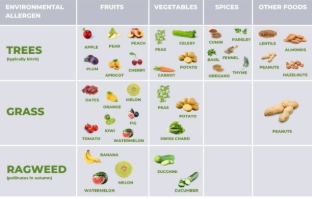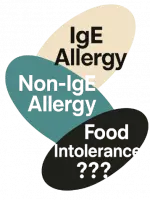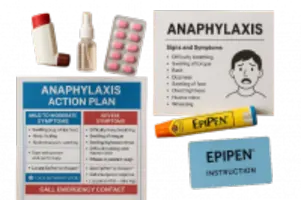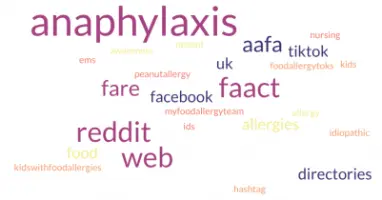
How to Survive
Practical Essential Information
Eight (8) In-depth Curated Topics

Cross Reactivity
If Allergic to x
maybe Also to Y
IgE, Non-IgE, or Food Intolerance
This resource distinguishes between three types of adverse food reactions.
- IgE-mediated allergies: Fast, potentially life-threatening, causing hives, respiratory issues, cardiovascular collapse, or anaphylaxis. Diagnosis includes skin-prick tests, IgE blood tests, and oral food challenges.
- Non-IgE allergies: Delayed, immune-mediated, often gastrointestinal (vomiting, diarrhea, poor growth, eczema). Examples include FPIES, FPIAP, and EoE. Typically non-fatal but impactful, sometimes outgrown in childhood.
- Food intolerances: Non-immune, digestive or chemical sensitivities (lactose intolerance, FODMAP sensitivity). They cause discomfort but not life-threatening reactions.
Management strategies vary: strict avoidance and epinephrine for IgE allergies; elimination diets and symptom monitoring for non-IgE reactions; and dietary modifications or enzyme supplements for intolerances. Prognosis differs, with some allergies resolving over time. The central theme is the importance of accurate medical diagnosis by professionals, not self-diagnosis, to ensure correct treatment and safetyIgE or Non-IgE 0r Food Intolera….
I Thought I Knew Food Allergies
This personal reflection blends lived experience with evidence from FARE’s Food Allergy Facts and Statistics. Despite managing 17 allergies within one family, the author discovered surprising gaps in knowledge. Key revelations included: over 170 foods can cause allergic reactions; food allergies qualify as disabilities under the ADA and Rehabilitation Act; advisory “may contain” labeling is voluntary; and antibacterial gels are ineffective against peanut protein. Studies show effective cleaning requires soap, wipes, or sprays, not dish liquid or sanitizers. The resource underscores that experience is not enough—continuous learning is essential. It reframes allergy management as a blend of vigilance, adaptability, and evidence-based practices. By sharing personal humility alongside authoritative facts, it encourages families to challenge assumptions and embrace updated scienceI thought I knew Food Allergies….
Hidden Dangers: The Importance of Food Label Literacy
This companion resource focuses on developing practical label-reading skills. It begins with the U.S. Top Nine allergens, but stresses that many others (corn, potatoes, sulfites) are not required by law. With 170+ foods capable of triggering reactions, hidden allergens may lurk under generic terms like starch, spices, or flavorings. The guide emphasizes vigilance: labels should be read at least four times (in store, at home, before use, and carefully word-by-word). It explains the pitfalls of “may contain” warnings, the risks of ingredient substitutions, and differences across packaging. Practical strategies include researching unfamiliar terms, contacting manufacturers, and staying alert to changes in formulations. By reframing food labels as dynamic rather than static, the resource arms allergy sufferers with habits and tools to minimize risk and make safer food choicesHidden Dangers_ The Importance ….
Food Labels Deception: Hidden Allergens Exposed
This resource critiques weaknesses in U.S. food labeling under FALCPA. It outlines how the “Top Nine” allergens (milk, eggs, wheat, soy, peanuts, tree nuts, fish, shellfish, sesame) must be listed clearly, including derivatives like “whey (milk).” However, advisory statements such as “may contain” are voluntary and unreliable, as studies show contamination can still occur at hazardous levels. It highlights hidden allergens in broad terms like spices or natural flavors, which may mask ingredients like paprika—a risk for nightshade allergy sufferers. Flavor compounds may also conceal multiple allergens under generic labeling. The article calls attention to variability in international regulations, noting that some countries require disclosure of more allergens than the U.S. For consumers, the message is that label literacy is essential but imperfect: hidden risks persist, particularly for uncommon allergiesFood Labels Deception_ Hidden A….
Anaphylaxis Resource Hub
Focused on managing life-threatening reactions, this hub aggregates 26+ resources across five categories: expert medical sites, symptom recognition, first aid in multiple languages, global 911 emergency numbers, and cultural insights. It stresses the urgency of identifying anaphylaxis symptoms (hives, swelling, breathing difficulty) and immediate epinephrine use. Translations in 20+ languages ensure accessibility worldwide. A travel-oriented section explains that emergency numbers vary internationally (e.g., 112 in Europe, 999 in the UK), providing a life-saving reference for allergic travelers. Another article explores how food allergies are not universally recognized, with cultural gaps in awareness creating risks abroad. Practical tips emphasize proactive communication and preparedness when visiting regions with low allergy literacy. Collectively, this hub offers a global, evidence-based toolkit for individuals and families to prepare for and respond effectively to anaphylaxisAnaphylaxis Resource Hub – Food….
EpiPen Hub
This hub centralizes essential knowledge about EpiPens (epinephrine auto-injectors). It explains what an EpiPen is, when and how to use it, and stresses immediate emergency care after administration. Key areas include storage guidance (avoiding extreme temperatures and checking for discoloration), safe disposal (via pharmacies or sharps containers), and expiration awareness. It also lists FDA-approved auto-injectors with comparisons of features, dosing, and availability. The “Six Expert Sites” section links to authoritative resources: the official EpiPen site, EPIPEN4SCHOOLS®, FARE, FDA safety alerts, California Education Code guidelines, and an international recommendations paper. Together, these provide medical, legal, educational, and patient-care perspectives. By consolidating clinical advice, school policies, and practical tips, the hub serves both caregivers and allergy sufferers who need confidence in emergency preparedness and device literacy epipen hub – FoodAllergy.World.
Best Social Platforms for Food Allergy Community
This guide highlights how social media and online communities provide vital emotional support, practical tips, and advocacy for individuals and families managing food allergies. It catalogs Facebook groups like CA Allergy Support & Anaphylaxis Prevention and No Nuts Moms LA, as well as national organizations such as FARE, FAACT, and AAFA. These groups offer resources ranging from peer support and recipes to legislative advocacy. Blogs and podcasts (e.g., Allergic Living, SnackSafely, Food Allergy and Your Kiddo) extend the support ecosystem with expert articles and firsthand stories. Instagram hashtags (#foodallergyawareness, #foodallergylife) and Twitter chats (#FoodAllergyChat) further connect communities globally. The resource underscores that AI tools (like ChatGPT) can help users find localized support groups. Its primary value lies in consolidating scattered communities into a structured directory, empowering users to find trusted peer groups, expert organizations, and social platforms tailored to their needsBest Social Platforms for Food ….
Comparison Matrix of Resources
| Resource | Main Focus | Practical Value |
|---|---|---|
| IgE, Non-IgE, or Food Intolerance | Diagnostic clarity | Helps patients & caregivers distinguish conditions and avoid misdiagnosis |
| I Thought I Knew Food Allergies | Personal reflection + science | Motivates ongoing learning; blends lived experience with FARE data |
| Food Label Literacy | Label-reading skills | Provides step-by-step reading habits (read 4x, research terms, contact manufacturers) |
| Food Labels Deception | Weaknesses in law | Raises awareness of systemic labeling flaws |
| Anaphylaxis Resource Hub | Emergency preparedness | Equips travelers & families with lifesaving global info |
| EpiPen Hub | EpiPen litera | Centralizes practical device info + legal/education resources |
| Best Social Platforms for Food Allergy | Community + advocacy | Directs users to peer support and awareness networks |










